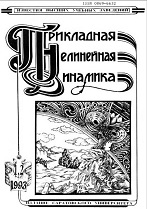|
MODELING OF GLOBAL PROCESSES. NONLINEAR DYNAMICS AND HUMANITIES
Bifurcation of public opinion created by social media algorithms
A. Krylov
Institute of Psychology, Russian Academy of Science, Moscow, Russia
Abstract:
The purpose of this work is to consider the possibility of nonlinear influence of social media algorithms to the users opinions. A social media inherent algorithm of information ranging interacts with the user inherent bias and that increases the positive feedback loop. The result of this interaction is receiving by the user the only one side of an opinion and the user looses the very possibility to receive the opposite information. The conditions for the society polarization by means of a social media are investigated. Methods. In this paper, a model of users opinions dynamics was studied. There are two types of user's strategy was considered: strategy 1, when a user puts "like" on information with proximity to his own view, but differed in any direction; strategy 2, when a user puts "like" on information along his own view, but more strict. Results. It was shown that for strategy 1 the society comes to a consensus, but for strategy 2 the society polarizes to the two opposite views. Considering the mixed society, where both strategies are used, it was found that the bifurcation to the society polarization appears when there are more than 40% of people using strategy 2. Conclusion. The inherent algorithms of social media, which are created to adapt in coming information to the user's interests, creates or amplifies the bias of the user's opinion and locks the user in an information chamber of only one type. That effect is substantially created by the social media algorithm itself. Thus interaction of users within a social media may increase the polarization of a society more than if they would communicate offline.
Keywords:
modeling, cognitive science, opinion dynamics, nonlinearity, Nonlinear systems, social science.
Received: 10.11.2021
Citation:
A. Krylov, “Bifurcation of public opinion created by social media algorithms”, Izvestiya VUZ. Applied Nonlinear Dynamics, 30:3 (2022), 261–267
Linking options:
https://www.mathnet.ru/eng/ivp476 https://www.mathnet.ru/eng/ivp/v30/i3/p261
|

| Statistics & downloads: |
| Abstract page: | 133 | | Full-text PDF : | 53 | | References: | 17 |
|




 Contact us:
Contact us: Terms of Use
Terms of Use
 Registration to the website
Registration to the website Logotypes
Logotypes








 Citation in format
Citation in format 